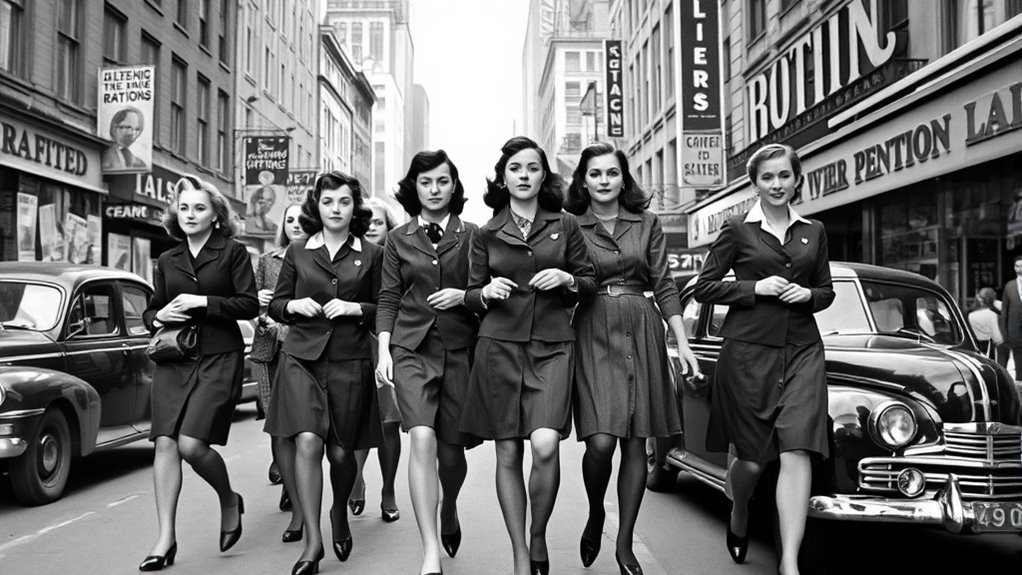During World War II, stocking rationing pushed you to get creative with fashion. Women recycled fabrics, decorated stockings, and embraced simpler, durable styles inspired by practical needs. Innovations like seamless, opaque hosiery and alternative fibers emerged, shaping lasting trends in sustainability and resourcefulness. These wartime changes emphasized practicality over luxury and fostered a culture of adaptability. If you want to discover how these resourceful styles still influence fashion today, there’s more to uncover.
Key Takeaways
- Stocking shortages led women to recycle fabrics, decorate stockings, and find innovative ways to mimic luxury hosiery.
- Wartime fabric rationing prompted the use of synthetic and recycled materials, fostering resourcefulness in fashion.
- Technological advances created durable, eco-friendly hosiery, influencing modern textile standards and sustainable design practices.
- Post-war fashion emphasized durability and practicality, promoting minimalist styles and ethical, eco-conscious production.
- Wartime resourcefulness ingrained a cultural shift toward sustainability, long-lasting garments, and responsible consumption in fashion.
The Origins of Rationing During Wartime
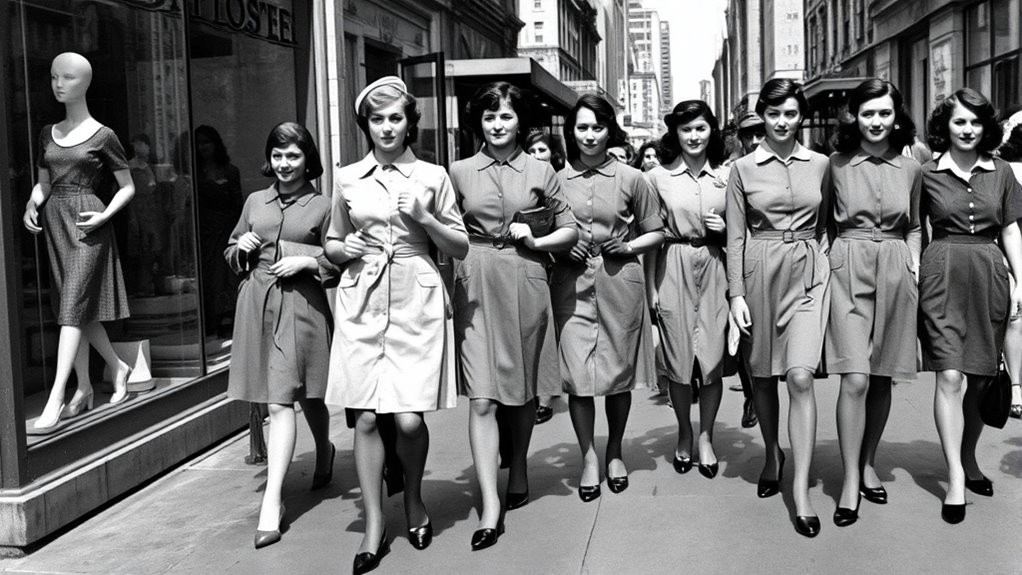
Have you ever wondered why governments implement rationing during wartime? It all started with material shortages caused by the war effort. As countries mobilized resources for the military, essential materials like rubber, fabric, and metals became scarce. To ensure fair distribution and support the war effort, governments introduced strict regulations. These government regulations limited the amount of resources civilians could use, including in everyday items like clothing. Rationing aimed to prevent hoarding and conserve materials for military needs. This system was a direct response to the shortages, forcing industries and consumers to adapt. By controlling supply and demand, governments managed the scarce resources effectively, shaping how people bought and wore clothing during wartime. Additionally, the impact on fashion was profound, leading to the use of cheaper fabrics and simpler designs. This rationing laid the foundation for lasting changes in fashion during and after the war.
Impact of Stocking Shortages on Women’s Fashion
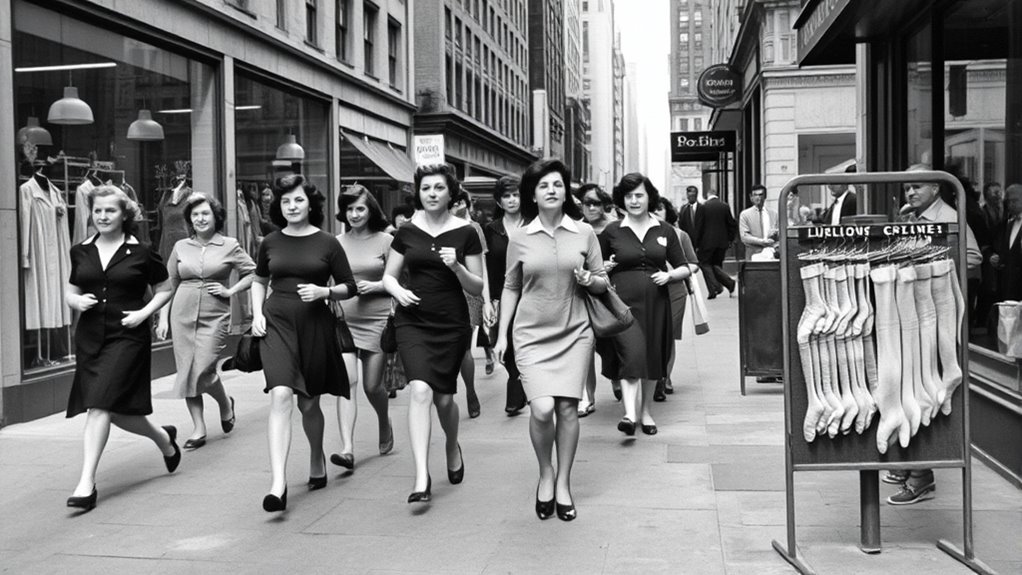
During World War II, shortages of stockings had a significant impact on women’s fashion, forcing many to adapt their everyday style. To maintain a polished look, women turned to vintage patterns, often repurposing old hosiery or creating new designs from limited supplies. This led to a resurgence of classic and intricate patterns that could be achieved with fewer materials. Textile recycling became essential, as women carefully mended or reused fabric scraps to extend the life of their stockings. Some even painted or decorated their stockings to imitate the appearance of more luxurious hosiery. These adaptations not only helped conserve resources but also fostered a sense of creativity and individuality. Additionally, the development of recycled products in materials helped women find innovative ways to stay stylish despite material constraints. Stocking shortages ultimately encouraged women to find innovative ways to stay stylish despite material constraints.
Creative Solutions: The Rise of Seamless and Opaque Hosiery
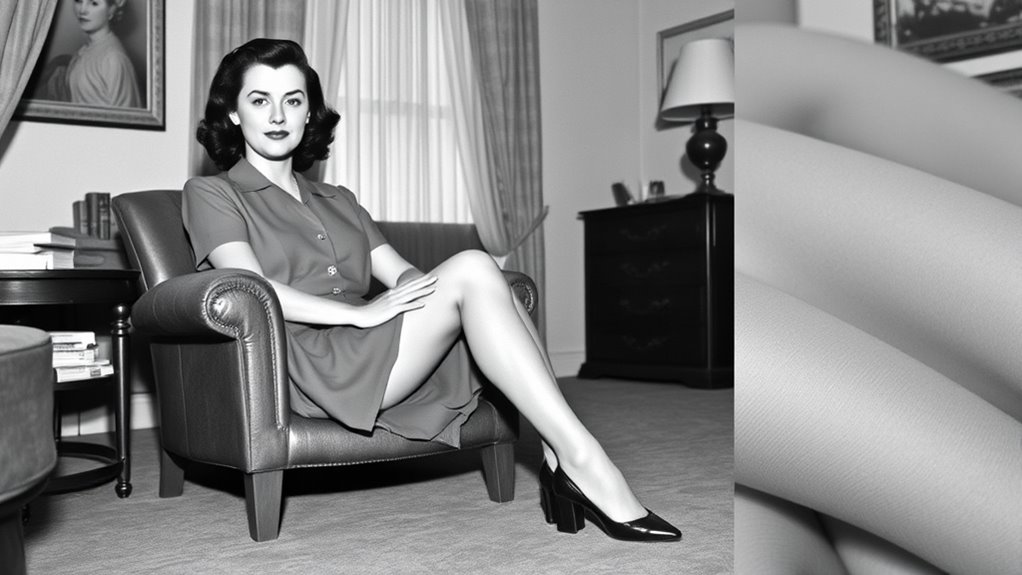
Innovations in fabric technology allowed manufacturers to create seamless and opaque hosiery that looks smooth and polished. These new materials enhanced the appearance of stockings, making them more attractive despite shortages. As a result, your wardrobe gains stylish options that maximize your look with fewer resources. Incorporating modern textile standards ensures that these stockings meet high quality and durability expectations, further boosting their appeal.
Innovations in Fabric Technology
Faced with rationing shortages, textile manufacturers turned to creative solutions that revolutionized hosiery technology. They developed innovative fabrics that used sustainable fibers, reducing material waste and environmental impact. These new textiles incorporated smart textiles technology, allowing stockings to be more durable and comfortable. These innovations also included fraud detection software that helped manufacturers monitor quality control and prevent counterfeits from entering the supply chain. The focus shifted toward high-performance materials that maintained style while conserving resources. You might notice advancements like reinforced toes and heels, plus opaque finishes that minimized the need for multiple layers. These innovations resulted in stockings that were not only more resilient but also easier to produce with limited resources. As a result, hosiery became more sustainable and adaptable, setting the stage for future textile breakthroughs. Overall, these innovations transformed hosiery into a more efficient and eco-friendly component of fashion.
Enhanced Hosiery Aesthetics
As fashion evolved during WWII, hosiery designers sought creative solutions to enhance both appearance and practicality. This led to a vintage revival of elegant styles, emphasizing seamless and opaque hosiery that looked more luxurious despite rationing limits. Women embraced these innovations, appreciating the smoother, more uniform look that concealed imperfections and added sophistication. Luxury embellishments, like subtle patterns and dark opaque shades, became popular, offering a touch of glamour without excess fabric. These improvements allowed stockings to appear more refined while conserving material. The focus on enhanced hosiery aesthetics transformed everyday essentials into fashion statements, proving that even under rationing, style could thrive through clever design and a return to classic elegance.
The Emergence of Alternative Materials and Manufacturing Techniques

During WWII, shortages of traditional materials pushed manufacturers to explore alternative options and new production methods. You begin to notice how designers turned to sustainable sourcing, utilizing unconventional fibers and recycled fabrics to meet demand. This period saw the rise of synthetic textiles like nylon and rayon, which offered durable, affordable alternatives to natural fibers. These innovations not only addressed shortages but also transformed fashion production for the future. The shift towards natural materials and their sustainable alternatives laid the groundwork for modern eco-friendly fashion practices.
How Designers Adapted to the Constraints

Designers responded to material shortages by rethinking their approaches to fashion creation. They embraced textile recycling, repurposing wartime uniforms and scrap fabrics into stylish garments. This shift not only minimized waste but also sparked innovation in design. You notice how many garments feature recycled materials, blending practicality with style. To understand these adaptations, consider this table:
| Strategy | Example | Impact |
|---|---|---|
| Textile Recycling | Repurposed uniforms, scrap fabrics | Reduced material use, sustainability |
| Simplified Designs | Minimalist silhouettes | Less fabric needed, functional fashion |
| New Materials | Rayon, cellulose-based fibers | Alternatives to scarce textiles |
| Functional Fashion | Multi-purpose clothing | Extended garment lifespan |
In addition, the focus on sustainable fashion encouraged designers to innovate further in their use of eco-friendly materials and production methods.
Cultural and Social Shifts Driven by Rationing Policies
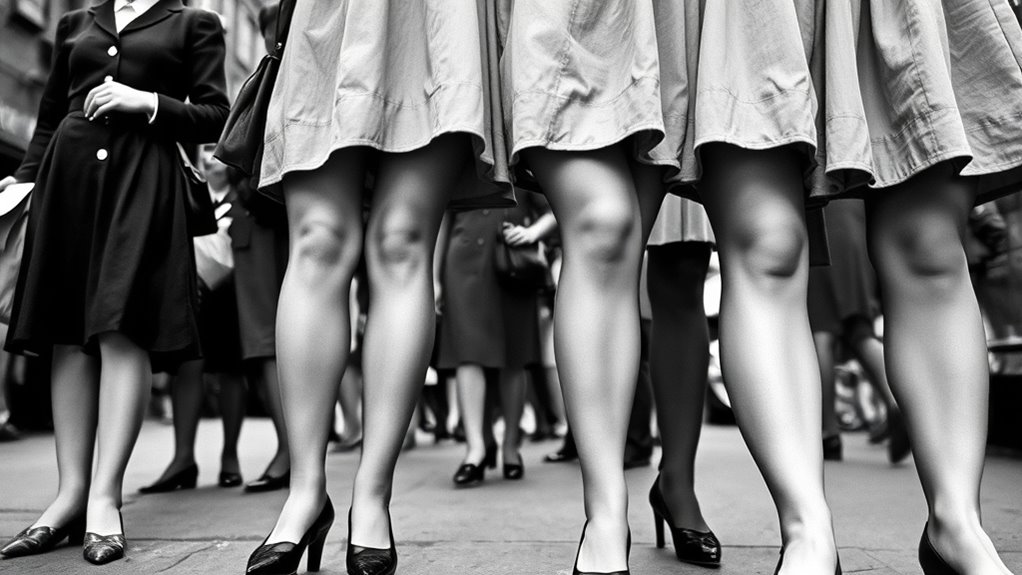
Rationing policies during WWII did more than conserve resources; they reshaped social behaviors and cultural norms. You notice how these restrictions fostered a sense of unity and resilience, influencing daily life and fashion choices. People sought creative ways to express their cultural identity within limited means, sparking a vintage revival of styles that emphasized practicality and simplicity. This shift encouraged community sharing and a focus on craftsmanship, reinforcing social bonds. As a result, fashion became a symbol of collective strength, inspiring designs that valued durability over excess. The wartime ethos persisted beyond the war, embedding itself in cultural memory and influencing future trends. Additionally, the emphasis on natural elements and resourcefulness in fashion reflected a broader desire for sustainability and mindful consumption. These social and cultural shifts left a lasting mark, transforming how society perceives style, identity, and resourcefulness.
The Enduring Influence of Wartime Styles in Post-War Fashion
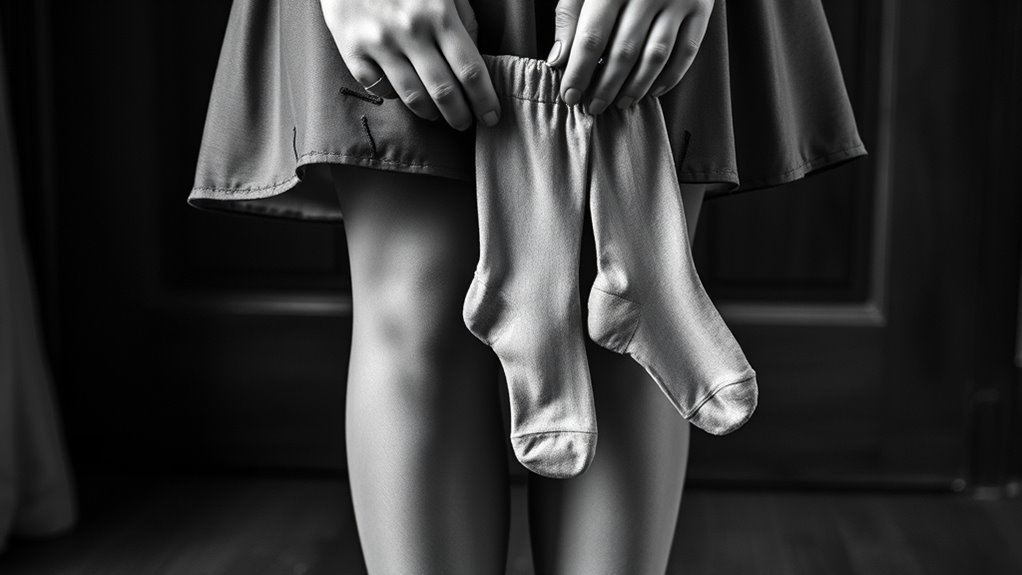
The resilience and practicality that characterized wartime fashion continued to influence styles long after the war ended. You’ll notice this in the continued preference for simple, durable designs, reflecting a shift toward sustainable sourcing. Post-war designers embraced quality over quantity, emphasizing long-lasting garments that minimized waste. This focus on durability aligns with modern ideals of ethical branding, where transparency and responsibility matter. Many brands today draw inspiration from wartime practicality by prioritizing eco-friendly materials and ethical production practices. The legacy of wartime styles encourages you to choose clothing that’s not only stylish but also mindful of environmental and social impacts. Additionally, the emphasis on versatile, multifunctional clothing from that era has led to a more mindful approach to wardrobe choices. This enduring influence shapes a fashion industry increasingly committed to sustainability and ethical sourcing, making these values core to contemporary design.
Lessons Learned and Innovations That Persist Today

Many of the innovations sparked by wartime shortages continue to shape today’s fashion industry. You can see this in the ongoing vintage revival, where designers draw inspiration from wartime styles to create sustainable, timeless pieces. Rationing taught us the value of resourcefulness, leading to more eco-conscious practices now rooted in fashion sustainability. You might notice:
- The reuse and repurposing of garments, inspired by wartime restrictions, remain popular.
- The embrace of minimalist, functional designs that prioritize durability over excess.
- A renewed focus on eco-friendly materials and processes, reflecting lessons learned from resource scarcity.
- Additionally, advances in AI-driven analytics help brands optimize resource use and reduce waste, further supporting sustainable practices.
These lessons emphasize that style doesn’t have to come at the environment’s expense, inspiring a more mindful approach to fashion that endures today.
The Legacy of Resourcefulness in Modern Fashion Industry
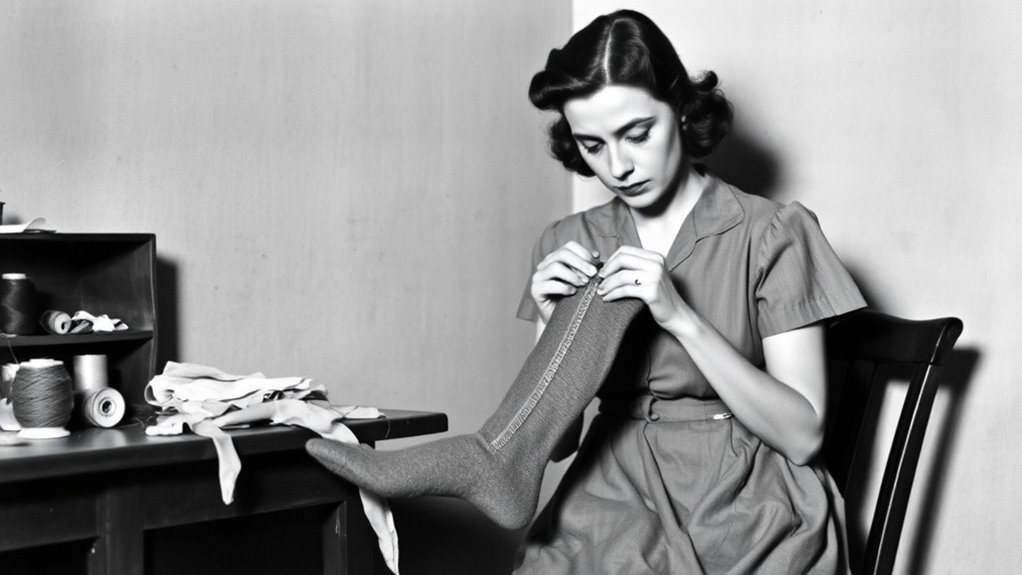
Resourcefulness has become a cornerstone of today’s fashion industry, shaping how you and designers approach clothing. You see it in sustainable practices that emphasize recycling, upcycling, and reducing waste. Brands now prioritize eco-friendly materials and transparent sourcing to minimize environmental impact. This mindset also influences how global supply chains operate, encouraging more localized production and ethical labor standards. You benefit from innovations inspired by wartime resourcefulness, such as designing versatile garments that last longer and adapt to changing trends. This legacy pushes the industry toward more responsible consumption, making you a conscious participant in sustainable fashion. By valuing resourcefulness, the modern fashion industry continues to evolve, balancing style with sustainability for a better future.
Frequently Asked Questions
How Did Wartime Rationing Influence Today’s Sustainable Fashion Practices?
Wartime rationing influenced today’s sustainable fashion practices by teaching you to value resourcefulness and durability. You now prioritize sustainable materials and fashion ethics, reducing waste and environmental impact. This history reminds you to design and choose clothing that lasts, supporting eco-friendly initiatives. As a result, you’re more conscious of your fashion choices, embracing sustainability and ethical production, ensuring your style contributes positively to the planet’s future.
Were There Any Long-Term Health Effects From Using Alternative Hosiery Materials?
Did you know that during wartime, women often used alternative hosiery materials, which sometimes caused hosiery allergies? Long-term health effects from these materials are rare but possible, especially if allergies develop. While most people didn’t face serious issues, some experienced skin irritation or sensitivities that could persist. It’s important to recognize that using unconventional materials might have had lasting impacts on individual health, even if widespread problems were uncommon.
How Did Men’s Fashion Adapt to Wartime Stocking Shortages?
During wartime stocking shortages, men’s hosiery faced significant challenges, prompting notable fashion adaptations. You might notice men opting for socks made from alternative materials or choosing styles that minimize the need for hosiery altogether. These changes reflect practical responses to shortages, leading men to adopt more versatile and durable options. As a result, wartime influence shifted men’s fashion toward simplicity and resourcefulness, shaping trends that persisted even after the shortages ended.
Did Wartime Hosiery Innovations Impact Global Fashion Industries Beyond Europe and America?
Imagine a world where a tiny innovation sparks a global fashion shift—you’re part of that story. Wartime hosiery innovations didn’t stay confined; they influenced global fashion industries well beyond Europe and America. As countries adapted, they embraced new materials and designs, transforming hosiery into a symbol of resilience and style worldwide. These innovations shaped trends and manufacturing practices, leaving a lasting mark on global fashion beyond the wartime era.
What Role Did Propaganda Play in Shaping Wartime Fashion and Resource Conservation?
Propaganda influence during wartime played a key role in shaping fashion by encouraging resource conservation. You’re likely to notice how posters and campaigns promoted ideas like modesty and practicality, urging you to reduce material use. This messaging reinforced the importance of resource conservation, inspiring you to adopt simpler styles and limit luxury items, which helped support the war effort. Propaganda effectively steered public behavior and fashion choices toward national priorities.
Conclusion
You’ve seen how wartime rationing pushed fashion to innovate and adapt, proving necessity really is the mother of invention. From creative hosiery solutions to sustainable materials, these changes shaped modern style in ways you still see today. Remember, necessity may be the mother of invention, but resourcefulness is its lifelong partner. Embrace these lessons, knowing that even in scarcity, ingenuity can transform the world of fashion for generations to come.
